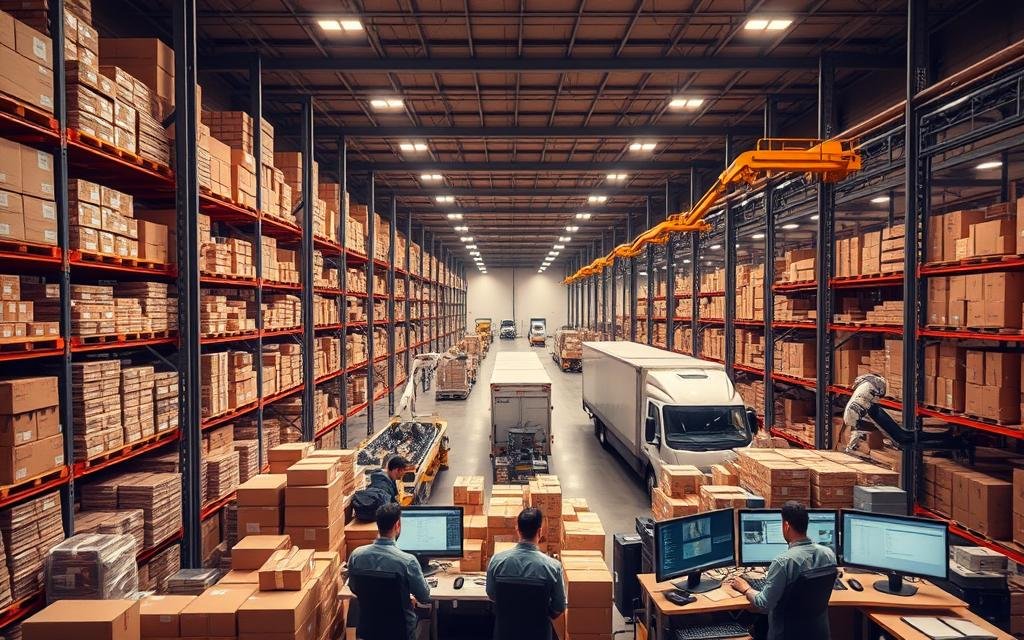Ever thought about how shipping and logistics in e-commerce can affect your business? In today’s fast-paced digital world, getting these right is not optional—it’s essential. Good shipping and logistics can boost customer happiness, help your business grow, and make online orders smoother.
Knowing how products move from the start to the end user is key. It helps improve processes and keep deliveries on time. Without solid logistics, you might miss customer expectations, leading to unhappy customers and lost sales.
Key Takeaways
- Shipping is a vital component of the e-commerce experience.
- Efficient logistics systems contribute to customer satisfaction.
- Optimizing shipping processes can lead to cost-effectiveness.
- Understanding order fulfillment is essential for online retailers.
- Timely deliveries are critical for keeping customers loyal.
Understanding the Role of Shipping in E-commerce
Shipping is key in e-commerce, affecting everything from how well things run to keeping customers happy. As online shopping grows, making sure shipping is fast and reliable is more important than ever. This not only makes the shopping experience better but also builds trust and loyalty with your customers.
The Impact on Customer Satisfaction
How well you ship your products can make or break your brand’s reputation. Quick deliveries, clear updates, and easy returns show customers you care. If shipping is slow or unclear, they might leave without buying or shop elsewhere. Knowing this helps you improve your shipping game.
Shipping Costs and Their Importance
What you charge for shipping matters a lot to shoppers. If your prices don’t match what customers expect, you could lose money and customers. By keeping shipping costs down, you can stay competitive. Being upfront about prices and giving customers choices helps everyone.
| Shipping Aspect | Impact on Customer | Importance for E-commerce |
|---|---|---|
| Delivery Speed | Higher satisfaction with faster delivery | Encourages repeat purchases |
| Shipping Costs | Direct influence on purchasing decisions | Critical for maintaining profit margins |
| Tracking Information | Frequent updates foster trust | Enhances overall customer experience |
| Return Policies | Ease of returns influences buying behavior | Supports customer retention and loyalty |
Types of Shipping Options Available
E-commerce businesses offer many shipping options to meet customer needs. Knowing these options helps you match your services with what your customers want. You can choose from standard and expedited shipping, and even consider international shipping and same-day delivery.
Standard vs. Expedited Shipping
Standard shipping is often the cheapest option, delivering orders in a few days. It’s great for those watching their budget. On the other hand, expedited shipping is faster but costs more. It’s for those who need their items quickly.
By having both options, you can meet different customer needs. This makes your shipping services more appealing to a wider audience.
International Shipping Considerations
Shipping internationally can help you reach more customers. But, it comes with its own set of challenges. You need to know about customs rules, tariffs, and taxes.
It’s important to be clear about delivery times and any extra costs. This helps build trust with your international customers.
Same-Day Delivery Trends
More and more customers want their orders right away. This has led to a rise in same-day delivery services. To offer this, you’ll need to work with local couriers and have a strong logistics system.
Keeping up with this trend can make your business stand out. It shows you’re committed to meeting customer needs quickly.
Choosing the Right Logistics Partner
Finding the best shipping carriers for ecommerce is key to your business success. It’s important to match your shipping needs with the right providers. Look at different factors to make a smart choice.
Evaluating Shipping Providers
Check out shipping providers based on important criteria:
- Reliability: Look at their history of meeting delivery times.
- Service Coverage: See where they can deliver.
- Cost: Compare prices to find what works for you.
- Customer Support: Check how well they help you.
Integrating Technology in Logistics
Technology is key to making logistics better. Use tools like inventory software and automation. This makes tracking better, cuts down on mistakes, and makes shipping smoother for your customers.
| Factor | Importance | Considerations |
|---|---|---|
| Reliability | High | On-time delivery rates |
| Service Coverage | Medium | Regional and international options |
| Cost | High | Competitive pricing for shipping |
| Customer Support | Medium | Availability of assistance |
Managing Inventory Effectively
Effective inventory management in ecommerce is key to boosting sales and cutting costs. Real-time inventory tracking systems help keep stock levels just right. This reduces the chance of running out of stock or having too much.
With real-time tracking, you can adjust to customer demand quickly. This makes your operations more efficient.
Real-Time Inventory Tracking
Tools for real-time inventory tracking keep stock levels accurate across all channels. This boosts transparency and customer satisfaction. It ensures you meet demand consistently.
Cloud-based inventory management solutions give you instant inventory data. This leads to smarter decisions and a more agile business.
Forecasting Demand for Seasonal Products
Demand forecasting is vital for busy seasons. Analyzing past sales and market trends helps predict what customers will want. This way, you can stock the right amount of seasonal products.
By understanding your inventory flow, you can increase profits and keep customers loyal.
| Inventory Strategy | Advantages | Challenges |
|---|---|---|
| Real-Time Inventory Tracking |
|
|
| Demand Forecasting |
|
|
Packaging Best Practices
Effective packaging is key for your e-commerce business. It affects shipping efficiency and customer happiness. Using sustainable packaging shows you care about the environment and meet customer needs.
Sustainable Packaging Solutions
Choosing eco-friendly packaging helps the planet and wins over green-conscious shoppers. Options like recycled cardboard, biodegradable plastics, and compostable fillers are great. They boost your brand’s image and help the environment.
Using less packaging also saves money on shipping. This is a big plus for both your wallet and the planet.
Designing for Shipping Efficiency
Designing packages smartly can cut down on shipping costs. Make sure your packages are the right size to avoid extra fees. This way, your items are safe and you save money.
Automating your packaging makes things faster and more consistent. This improves how well your business runs.
Customs and Regulations in International Shipping
Understanding customs rules for ecommerce is key to successful international shipping. Knowing about tariffs helps you avoid surprise costs. These costs can affect your prices a lot. Having the right shipping documents is also important for easy customs clearance.
Understanding Duties and Taxes
When you ship across borders, you need to know about duties and taxes. These can change a lot based on what you’re shipping, where it comes from, and where it’s going. Knowing these costs helps you set prices right and follow local laws.
Documentation Required for Cross-Border Shipments
For smooth shipping, you need the right documents. Here are the main ones:
- Commercial Invoices: Show the deal, including what’s being sold and how it’s paid for.
- Packing Lists: List what’s in each package.
- Certificates of Origin: Say where the goods were made.
- Harmonized System (HS) Codes: Help figure out customs duties.
With the right documents, you avoid delays and get your goods delivered on time.
The Importance of Shipping Policies
Having good shipping policies is key for ecommerce businesses. It builds trust with customers and makes their shopping better. Clear return policies help customers feel more at ease when buying online. They know returning items is easy and understand the rules.
Return and Refund Policies
Return policies should tell customers how to return items. They should say how long they have, what condition items must be in, and any costs. Clear return policies help reduce worries about online shopping, leading to more sales.
Setting Clear Delivery Expectations
It’s important to set clear delivery expectations. Customers like knowing when their orders will arrive. Being open about delivery times, any delays, and tracking helps a lot.
When customers know where their order is, they trust your service more. This leads to them coming back for more.
The Role of Technology in E-commerce Logistics
Technology is key in today’s e-commerce world, making things more efficient and accurate. The right tools can make your operations smoother and improve customer satisfaction. Inventory management tech and logistics automation are at the heart of this, cutting costs and improving delivery times.
Inventory Management Software
Using good inventory management software lets you keep an eye on stock levels in real-time. This tech helps avoid overstocking and running out of items. It helps you make better choices about what to order and how much, keeping customers happy.
Automating Shipping Processes
Logistics automation is vital for better shipping. It automates tasks like printing labels and sending out orders. This cuts down on mistakes and speeds up delivery, making your business run better and customers happier.
Building a Seamless Omnichannel Experience
Creating a seamless omnichannel experience in ecommerce boosts customer engagement and loyalty. It’s key to connect online and offline sales to meet customer needs. By doing so, you offer various shopping methods, making it more convenient for your audience.
Connecting Online and Offline Sales
Integrating online and offline sales is vital for today’s retail strategies. Customers want a unified shopping experience, whether online or in stores. This integration boosts product discovery and satisfaction, as customers interact with your brand in different ways.
Click-and-Collect Options
Click-and-collect services are gaining popularity. They let customers order online and pick up products at a nearby store. This service cuts down on shipping costs and adds convenience for customers. Stores like Target and Best Buy use it to offer quick access to products while meeting customer needs.
Measuring Shipping Performance
Good logistics management means keeping track of shipping performance. It helps spot what’s working and what’s not. This way, you can make your shipping better. It’s all about making your operations more efficient.
Key Metrics to Track
There are a few important shipping metrics to watch:
- On-Time Delivery Rate: Shows how many packages arrive on time.
- Shipping Cost as a Percentage of Sales: Tells you how much shipping costs compared to sales.
- Customer Satisfaction Ratings: Helps you see how shipping affects customers’ happiness.
By checking these metrics often, you can find areas to improve. This makes your logistics work better for your business. For more details, check out this resource.
Analyzing Customer Feedback
Listening to what customers say about shipping is key. It shows what they like and dislike. This helps you make changes to make them happier.
It’s important to talk to customers and listen to their feedback. This way, you can always be getting better at shipping. Using metrics and feedback together helps you do great in logistics.
Trends Shaping the Future of E-commerce Logistics
The world of e-commerce logistics is changing fast. New technologies like drones are making deliveries quicker and more efficient. It’s important to watch how these changes fit with green shipping practices to meet customer needs and follow the law.
Drones and Autonomous Vehicles
Drones and self-driving cars are making big promises for faster delivery. Companies are testing them out, showing they can cut down on delivery time and costs. This means better service for customers, which is key in the fast-changing world of future trends in logistics.
Sustainable Practices in Shipping
More people want eco-friendly shipping options. This is pushing retailers to choose greener ways to send packages. They’re using carbon-neutral methods, biodegradable packaging, and smarter routes to cut down on pollution. This not only pleases customers but also supports global green efforts.
By keeping up with these trends, you can make your logistics better for the future.
Preparing for Peak Shipping Seasons
As peak shipping seasons approach, managing high demand is key to your business’s success. Strategic planning is vital to handle the surge in orders efficiently. Start by anticipating seasonal demand spikes to prepare your inventory and logistics.
Strategies for Managing High Demand
Effective peak shipping strategies are essential for a successful busy season. This might mean increasing production, optimizing your supply chain, and improving shipping processes. Analyzing consumer trends and sales data helps make informed decisions based on demand.
Leveraging Third-Party Fulfillment Services
Using third-party fulfillment services is a smart way to manage seasonal demand. These services offer warehousing and shipping, helping you scale quickly. They ensure you can fulfill orders promptly and keep customers happy. Make the most of these services to keep your logistics flexible and strong all year.



